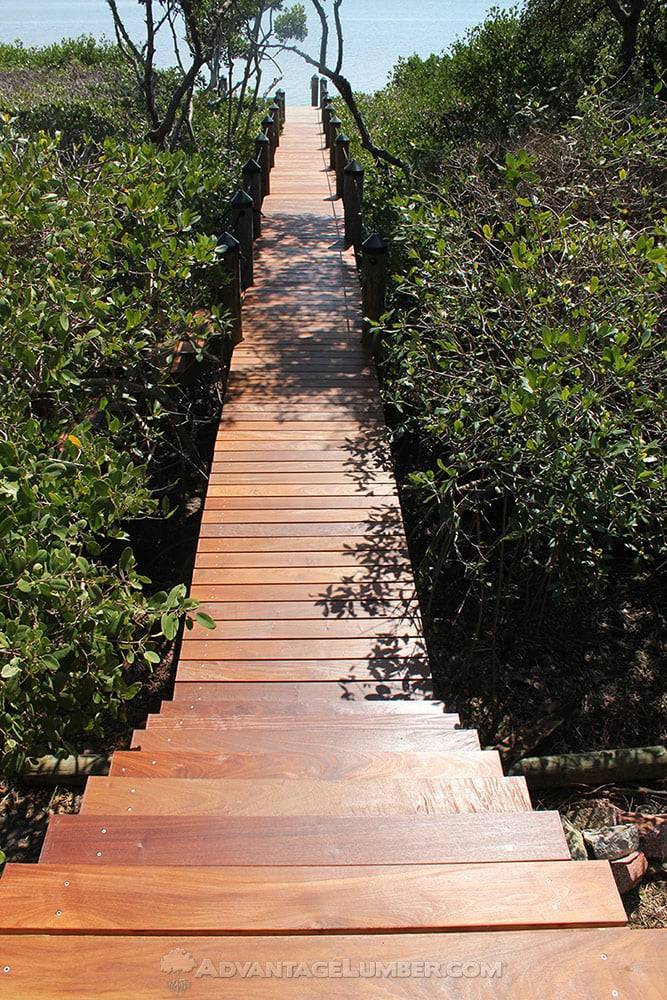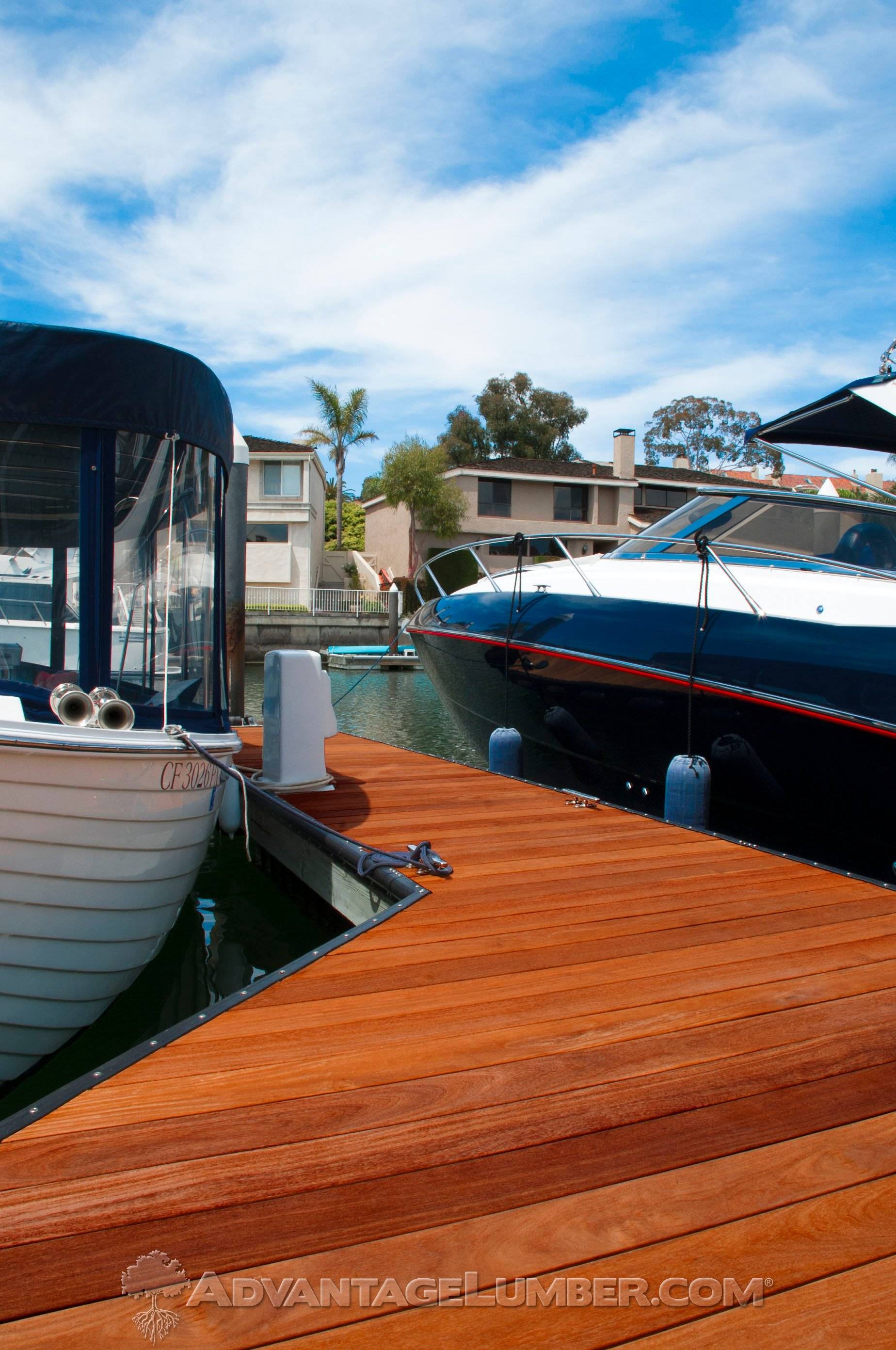If you are looking to build or rebuild a boat dock you want the most durable wood that will last a lifetime with very little maintenance.
A boat dock see’s some incredibly harsh conditions since they are so close to the water they are typically getting abuse from waves and are often constantly saturated with water.
Constant moisture is an enemy for all boat dock materials whether they are wood or composite. In fact constant moisture can lead to faster rot and decay, mold and mildew and leave you with excessive maintenance.
Boat Dock Materials Pros and Cons
Pressure Treated Pine
Pressure treated pine is the most common and affordable type of wood commonly used for boat docks.
The pros of using this material is the initial cost is the cheapest compared to other options. This material should last you 20 years or more with annual maintenance.
The cons are the annual maintenance that will be required. A Pressure treated pine boat dock will need to be sealed every year or every other year with a water sealer to keep the water from saturating the wood.
If this is not done it will lead to early rot and decay of your boat dock since pine is a soft wood. Soft woods are more prone to rot and decay, insect attack as well as mold, algae and fungi growth.
The regular maintenance costs will add up over the lifetime of your dock so make sure you plan for the square footage of you boat dock and how much water sealer you would need as well as the other materials needed (pressure washer, brushes and etc…)
Pressure treated pine is also known to splinter overtime which can be bad for a boat dock if you are using your dock with bare feet. Many boat docks also serve as a swim platform with a ladder built on.

The pressure treated pine boat dock above has weathered severely. Additionally the wood has splinters all over and is rotted in parts that had seen more water.
Cedar Wood
Another softwood option is Cedar which is considered an upgrade compared to treated pine.
Although Cedar is known to have some natural rot resistance but it still requires a water sealer applied every year or every other year to keep the water from rotting the wood.

In the picture above you can see it still splinters and will rot which is why the deck board above is being replaced. The waterproofing sealer will eventually flake off as seen in this photo.
Pros:
- 25+ year lifespan
- Can be stained
- Some natural rot resistance
- Not hot on bare feet
Cons:
- Requires annual maintenance with a waterproofing sealer that will eventually peal off.
- Contains knots
- Splinters will eventually occur
- Will eventually rot
Composite Dock Materials
Composite deck and dock materials have built a notion that it is maintenance free. For years composite decking manufacturers advertised their products as maintenance free.
Eventually there were some class action lawsuits that followed once homeowners found that these products were not maintenance free.
The truth is there is no such thing as maintenance free especially outdoors. Even inside you don’t have maintenance free kitchen floors so you should stop thinking maintenance free and realize that everything will require some maintenance.
On top of that some of these man made composites have held up well and some have completely crumbled causing more class action lawsuits for these decking products.

In the picture above the boat dock was built with a composite decking material. It has mold growing on the surface, the surface has been wearing off and is badly pitting which leads to more mold growth.
The outer skirting board is also badly deteriorating and crumbling.
Pros:
- Low Maintenance
- Made from recycled materials
- Rot resistant
- Most manufacturers offer 20+ year warranties
Cons:
- Can be hot on bare feet
- Many homeowners report that it’s very slippery when wet
- Can not be refinished
- Expensive
If this is the option you are choosing we advise you to do some Google searches for reviews on the brand you are interested in. For example ” Brand Name decking complaints” and “Brand Name decking problems”.
If you do your research on Google you will often find if other homeowners have had a lot of issues with those products.
Exotic Hardwood Boat Dock Materials
There are many South American hardwood products that have proven to last 75+ years with very little maintenance. These species we recommend are Ipe, Cumaru, Tigerwood, Massaranduba and Garapa.
These hardwoods are sustainably harvested and are naturally resistant to rot, mold, mildew and wood boring insect
In addition they do not deteriorate like softwoods so even after many years they are still safe to walk on barefoot. Also the wood is not hot to walk on barefoot like most plastic decking materials. This makes them some of the best choices for boat dock materials.
If you plan to build your new boat dock with one of these hardwood species you can save significantly by using short length boards
Pros:
- Low Maintenance
- Made from sustainable wood
- Rot resistant
- Proven to last 75+ Years
- Resistant to mold and mildew
- Does not get hot on bare feet like plastic materials
- Can be refinished
- Can be left to gray for the ultimate low maintenance dock
Cons:
- More expensive initial investment
- Requires annual oiling to maintain color







Excellent information about many boat dock flooring materials. I appreciate the pros and cons.
When building an exotic wood dock, do you need to building the frame out of the exotic wood too? What are the pros and cons of the framing material
You do not have to use exotic wood for the framing, pressure treated is most commonly used. We do recommend using joist tape made by DeckWise applied to the top of every joist. You can certainly use exotic wood for the frame if your budget allows but it’s not necessary.
Hello,
I am Joseph Scordas and I would like to know if you have Dock Boards available.if yes,then get back to me with the types and prices and also the major credit cards you accept.Thank You.
Best Regards.
Joseph S.
You can find all the information you’re looking for here: https://www.advantagelumber.com/docks/
Will an aluminum dock frame support Tiggerwood or IPE decking. Looking to replace my cedar decking. How do these woods compare in weight?
You need to look up the specs on your aluminum dock frame we can not tell you what it’s engineered to support. Ipe and Tigerwood are heavier than Cedar, Ipe is the heaviest and 3/4″ thick finished material weights approx. 4.5 pounds per square foot. If your dock frame can support that which it probably can than you are fine.
Hi
I just installed and Ipe deck using your products.
It is beautiful and we made sure to leave room for air circulation to keep it from cupping.
I am wondering how/why Ipe would be used in a boat dock application where it will sit a few inches a from the water at all times. Seem counterintuitive??
Thanks!
For an application like a boat dock the best size decking to use would be 5/4 x 4 since thicker narrower boards are less likely to cup. We do have plenty of customers who use the standard 6 inch deck boards without any issue. Typically on many lakes there’s plenty of air flowing around all sides of the boat dock so the decking being closer to water is not usually an issue. If you are building a boat dock in a shaded swamp that doesn’t get much air flow then you might have some issues down the road with any decking you use. For decks where the house itself is a giant wind block and might be surrounded by trees if you were to skirt of the deck very tightly and have it too close to the ground you essentially could have a humidor under your deck since you have ground moisture and no air movement and then the top of the deck would be getting air movement and sun. Anytime you create two completely different environments on the top and back side of a board you can experience cupping and other undesirable movement in your deck boards
I have a cantileved dock about 2-3 feet above a river for which I need to replace or at least “shore up” some 16 foot long 2 x 8 support beams that are directly under composite floor boards (they’re fine). The river is in Northern Indiana. The dock was built in 2007 and used treated lumber but it has rotted* from the top down. Most of the boards are OK and even the damaged ones are fine in the lower 4-5 inches and only rotted fort about 4-5 feet, mostly in the center (end to end) of the board, is damaged. Should I just get treated lumber again? It was supposed to last 20 years and if I could rely on that to happen that would be my choice but someone suggested just getting cheaper wood and “painting” it w/ a sealer. I don’t need it to last more than 20-25 years since I will not own the dock in 15-25 yrs.
*I can’t tell if it’s water damage (I think so) or from wood eating insects.
We would recommend getting a qualified dock builder and getting their expert opinion based on your application, materials and location.
Hello,
So I live in Oregon and I just had a dock that leads to the river and in the river made. I was told that the is a red flag on it due to it not being environmentally safe using the pressure treated wood purchased today. Any information on whether this can be fixed, treated to not be hazardous to the river, would be much appreciated.
THanks-
Sandee
Almost all dock are built with pressure treated lumber for the frame. You can reach out to the manufacturer that you bought your wood from to get the specifics about your wood you used. The old pressure treated prior to 2004 contained arsenic: https://www.epa.gov/ingredients-used-pesticide-products/chromated-arsenicals-cca the newer pressure treated wood typically uses preservatives approved by the EPA. So as long as you purchased you lumber recently you should be fine but check with the manufacturer of your pressure treated lumber to be certain.
What’s the best word for a swim platform on a sailboat?
We sell many woods that work great for swim platforms such as Ipe, Cumaru and Teak would be our top 3.